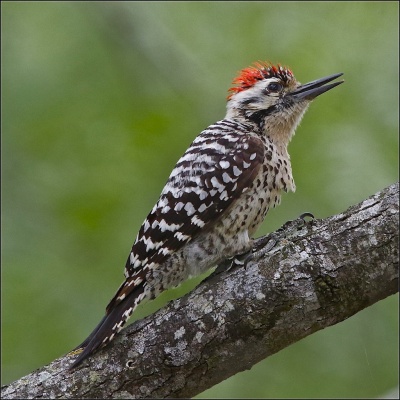(Clearer image. Attempt to disguise more copied text. Some extra info. Incomplete gone) |
|||
| (13 intermediate revisions by 6 users not shown) | |||
| Line 1: | Line 1: | ||
| − | {{ | + | [[Image:Ladder-backed Woodpecker male.jpg|thumb|400px|right|Male ''D. s. cactophilus''<br />Photo © by {{user|Stanley+Jones|Stanley Jones}} <br />Edinburg Scenic Wetlands, Edinburg, Hidalgo County, [[Texas]], [[USA]], April 2019]] |
| + | ;[[:Category:Dryobates|Dryobates]] scalaris<br /> | ||
| + | ''Picoides scalaris; Dendrocopos scalaris; Picus scalaris'' | ||
| + | ==Identification== | ||
| + | [[Image:Ladder-backed_Woodpecker,_Femalebobsofpa.jpg|thumb|350px|right|Female ''D. s. cactophilus''<br />Photo © by {{user|bobsofpa|bobsofpa}} <br />Ash Canyon, [[Arizona]], [[USA]], 29 April 2010]] | ||
| + | 16.5 to 19 cm (6½ to 7½ inches) in length<br /> | ||
| + | Straight black bill | ||
| + | *Black and white, barring on back and wings | ||
| + | *Black spotted, white underparts and rump<br /> | ||
| + | Adult males | ||
| + | *Red crown to nape (smaller in immatures) | ||
| + | *Buff forehead | ||
| + | *Black forecrown with red feather tips<br /> | ||
| + | Adult female has a black crown | ||
| + | ====Similar Species==== | ||
| + | [[Nuttall's Woodpecker]] is similar but darker with broader dark bars across back and face. | ||
| − | |||
| − | |||
| − | |||
| − | |||
==Distribution== | ==Distribution== | ||
South-western [[United States]], [[Mexico]], and [[Nicaragua]]. | South-western [[United States]], [[Mexico]], and [[Nicaragua]]. | ||
==Taxonomy== | ==Taxonomy== | ||
| + | ====Subspecies==== | ||
| + | There are 8 subspecies<sup>[[#References|[1]]]</sup>: | ||
| + | *''D. s. cactophilus'': | ||
| + | :*Arid south-western [[US]] to north-eastern Baja California and central [[Mexico]] | ||
| + | *''D. s. eremicus'': | ||
| + | :*Northern Baja California | ||
| + | *''D. s. lucasanus'': | ||
| + | :*Southern Baja California | ||
| + | *''D. s. graysoni'': | ||
| + | :*Tres Marías Islands (off western Mexico) | ||
| + | *''D. s. sinaloensis'': | ||
| + | :*Coastal western Mexico (southern Sonora to Guerrero, south-western Puebla, western Oaxaca) | ||
| + | *''D. s. scalaris'': | ||
| + | :*Southern Mexico (Veracruz and Chiapas) | ||
| + | *''D. s. parvus'': | ||
| + | :*North Yucatán Peninsula, Cozumel Island and Holbox Island | ||
| + | *''D. s. leucoptilurus'': | ||
| + | :*[[Belize]], [[Guatemala]] and [[El Salvador]] to north-eastern [[Nicaragua]] | ||
| + | |||
==Habitat== | ==Habitat== | ||
| − | + | Deserts and open woodland in very dry areas; also woods along seasonally dry water courses. | |
==Behaviour== | ==Behaviour== | ||
| − | They nest in cavities excavated | + | ====Breeding==== |
| − | Diet | + | They nest in cavities excavated in tree trunks. Their clutch contains 2 to 7 plain white eggs which are incubated by both adults. |
| − | + | ====Diet==== | |
| + | Their diet consists mostly of insects, invertebrates and their larva, such as beetles, caterpillars and ants; they also eat some fruit. | ||
| + | ==References== | ||
| + | #{{Ref-Clements6thAug18}}#[https://avibase.ca/2CE418F2 Avibase] | ||
| + | #Handbook of the Birds of the World Alive (retrieved May 2019) | ||
| + | {{ref}} | ||
==External Links== | ==External Links== | ||
| − | {{GSearch| | + | {{GSearch|Woodpecker+scalaris}} |
| − | [[Category:Birds]] [[Category: | + | [[Category:Birds]] [[Category:Dryobates]] |
Revision as of 23:11, 14 May 2019

Photo © by Stanley Jones
Edinburg Scenic Wetlands, Edinburg, Hidalgo County, Texas, USA, April 2019
- Dryobates scalaris
Picoides scalaris; Dendrocopos scalaris; Picus scalaris
Identification
16.5 to 19 cm (6½ to 7½ inches) in length
Straight black bill
- Black and white, barring on back and wings
- Black spotted, white underparts and rump
Adult males
- Red crown to nape (smaller in immatures)
- Buff forehead
- Black forecrown with red feather tips
Adult female has a black crown
Similar Species
Nuttall's Woodpecker is similar but darker with broader dark bars across back and face.
Distribution
South-western United States, Mexico, and Nicaragua.
Taxonomy
Subspecies
There are 8 subspecies[1]:
- D. s. cactophilus:
- D. s. eremicus:
- Northern Baja California
- D. s. lucasanus:
- Southern Baja California
- D. s. graysoni:
- Tres Marías Islands (off western Mexico)
- D. s. sinaloensis:
- Coastal western Mexico (southern Sonora to Guerrero, south-western Puebla, western Oaxaca)
- D. s. scalaris:
- Southern Mexico (Veracruz and Chiapas)
- D. s. parvus:
- North Yucatán Peninsula, Cozumel Island and Holbox Island
- D. s. leucoptilurus:
- Belize, Guatemala and El Salvador to north-eastern Nicaragua
Habitat
Deserts and open woodland in very dry areas; also woods along seasonally dry water courses.
Behaviour
Breeding
They nest in cavities excavated in tree trunks. Their clutch contains 2 to 7 plain white eggs which are incubated by both adults.
Diet
Their diet consists mostly of insects, invertebrates and their larva, such as beetles, caterpillars and ants; they also eat some fruit.
References
- Clements, J. F., T. S. Schulenberg, M. J. Iliff, D. Roberson, T. A. Fredericks, B. L. Sullivan, and C. L. Wood. 2018. The eBird/Clements checklist of birds of the world: v2018. Downloaded from http://www.birds.cornell.edu/clementschecklist/download/
- Avibase
- Handbook of the Birds of the World Alive (retrieved May 2019)
Recommended Citation
- BirdForum Opus contributors. (2024) Ladder-backed Woodpecker. In: BirdForum, the forum for wild birds and birding. Retrieved 16 April 2024 from https://www.birdforum.net/opus/Ladder-backed_Woodpecker




